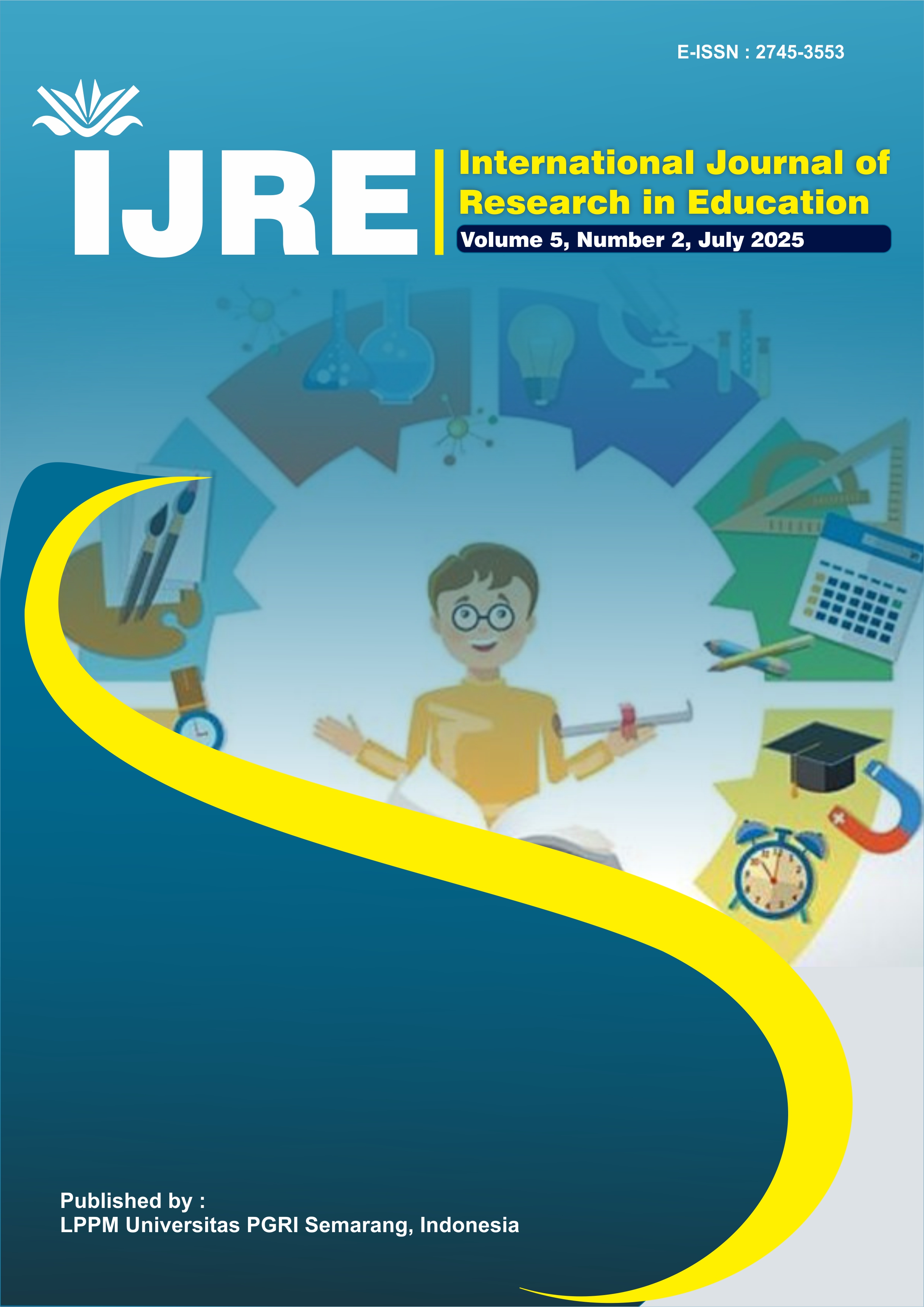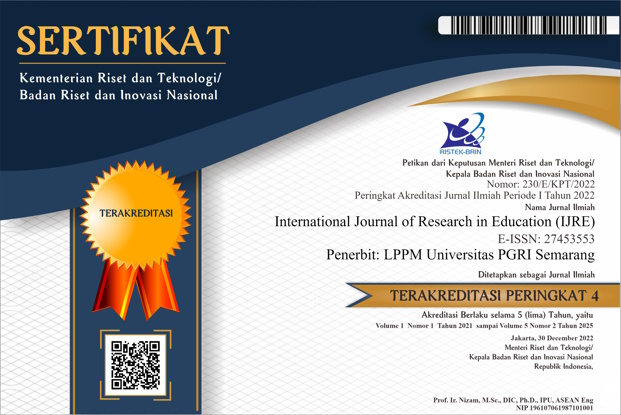EFL Students’ Perception of DeepL Translation Tool Utilization in Translating Scientific Published Research Articles
DOI:
https://doi.org/10.26877/kghjpe40Keywords:
EFL students , Perception , DeepL translation tool , Transalting articles, Thesis writingAbstract
Artificial intelligence (AI) technology advancements have given us language learning tools like DeepL, renowned for its translation accuracy and fluency. Students often use DeepL to understand scientific published articles for the purpose of composing thesis paper in the final year of their study. However, research on students' perceptions of the use of DeepL, especially in the translation of scientific articles, is still limited. This study aims to explore the perceptions of tertiary EFL students towards DeepL utilization, particularly in helping them to understand scientific articles in English. This research used a qualitative approach with a case study design. Data were collected through in-depth interviews with final-year students who were selected using a purposive sampling technique. Data analysis was conducted using Braun and Clarke's (2006) thematic analysis method. The results showed that students have positive perceptions of DeepL because of its ability to translate complex academic terms, provide accurate and contextual translations, and accelerate understanding of academic literature. In addition, students consider DeepL is easy to use, accessible on various devices, and rarely experience technical problems. Most students plan to continue using DeepL in their academic studies and recommend it to their peers. This finding confirms that DeepL has an important role as a translation tool in supporting students' understanding of English scientific articles in thesis writing.
References
Aguilar, A. P. (2023). Challenging machine translation engines: some Spanish-English linguistic problems put to the test. *Cadernos de Traducao*, *43*(1), 1–26. [https://doi.org/10.5007/2175-7968.2023.e85397](https://doi.org/10.5007/2175-7968.2023.e85397)
Birdsell, B. (2022). Student writings with DeepL: teacher evaluations and implications for teaching. *JALT Postconference Publication*, *2021*(1), 117. [https://doi.org/10.37546/jaltpcp2021-14](https://doi.org/10.37546/jaltpcp2021-14)
Bowker, L. (2020). Machine translation literacy instruction for international business students and business English instructors. *Journal of Business and Finance Librarianship*, *25*(1–2), 25–43. [https://doi.org/10.1080/08963568.2020.1794739](https://doi.org/10.1080/08963568.2020.1794739)
Braun, V., & Clarke, V. (2006). Using thematic analysis in psychology. *Qualitative Research in Psychology*, *3*(2), 77–101. [https://doi.org/10.1191/1478088706qp063oa](https://doi.org/10.1191/1478088706qp063oa)
Bunga, E. L. M., & Katemba, C. V. (2024). Comparing translation quality : google translate vs DeepL for foreign language to English universitas advent Indonesia , Indonesia Although so many people around the world use only their mother tongue as the basis of their daily language , no government t. *Edusaintek: Jurnal Pendidikan, Sains Dan Teknologi*, *11*(3), 1147–1171. [https://doi.org/https://doi.org/10.47668/edusaintek.v11i3.1264](https://doi.org/https://doi.org/10.47668/edusaintek.v11i3.1264)
Campbell, S., Greenwood, M., Prior, S., Shearer, T., Walkem, K., Young, S., Bywaters, D., & Walker, K. (2020). Purposive sampling: complex or simple? research case examples. *Journal of Research in Nursing*, *25*(8), 652–661. [https://doi.org/10.1177/1744987120927206](https://doi.org/10.1177/1744987120927206)
Candela, A. G. (2019). Exploring the function of member checking. *Qualitative Report*, *24*(3), 619–628. [https://doi.org/10.46743/2160-3715/2019.3726](https://doi.org/10.46743/2160-3715/2019.3726)
Creswell, J. W., & Creswell, J. D. (2018). *Research design qualitative, quantitative, and mixed methods approaches* (Fifth). SAGE Publications.
Cummings, R. E., Monroe, S. M., & Watkins, M. (2024). Generative AI in first-year writing: an early analysis of affordances, limitations, and a framework for the future. *Computers and Composition*, *71*, 102827. [https://doi.org/10.1016/j.compcom.2024.102827](https://doi.org/10.1016/j.compcom.2024.102827)
Davis, F. D. (1989). Perceived usefulness, perceived ease of use, and user acceptance of information technology. *MIS Quarterly: Management Information Systems*, *13*(3), 319–340.
Khairyah, P. N., Anastasya, M., & Natsir, R. Y. (2024). A phenomenological study of English education students’ perceptions of using DeepL pro for text translation. *IJM : Indonesian Journal of Multidisciplinary*, *2*, 610–619.
Kirana, A., Repelita, F., Kembaren, W., Ichsanda, B., & Hz, R. (2024). The Influence of deepl translator on EFL students’ writing. *Humaniora Dan Seni (JISHS)*, *02*(4), 746–753.
Laksana, K. N., & Komara, C. (2024). Indonesian EFL students ’ perceptions of DeepL machine translation tool : utilization , advantages , and disadvantages. *Jolls: Journal of Language and Literature Studies*, *4*(2), 256–276. [https://doi.org/https://doi.org/10.36312/jolls.v4i2.1931](https://doi.org/https://doi.org/10.36312/jolls.v4i2.1931)
Maulina, Hastianah, & Herianah. (2023). Undergraduate students ’ perception of the use of WhatsApp-Based speaking instructional materials. *Indonesian Tesol Journal*, *5*(1), 58–75.
Maulina, Ignacio, J. F., Bersabe, L. A. C., Serrano, A. J. D., Carpio, N. G., & Santos, E. G. D. (2022). Technology-Based media used in teaching listening skills. *Exposure: Jurnal Pendidikan Bahasa Inggris*, *11*(1), 85–99.
Maulina, M., Dayana, U., Nasrullah, R., Geelan, D., & Cortez, A. O. (2024). Educational research methodology trends of southeast Asia Englishmajor undergraduate theses : a content analysis. *Al-Ishlah Jurnal Pendidikan*, *16*(3), 3179–3192. [https://doi.org/10.35445/alishlah.v16i3.4698](https://doi.org/10.35445/alishlah.v16i3.4698)
Maulina, M., Nasrullah, R., & Wanci, R. (2022). Social media utilization for self-regulated English learning during COVID-19 outbreaks. *Tell : Teaching of English Language and Literature Journal*, *10*(1), 75–83.
Marikyan, D., & Papagiannidis, S. (2024). Technology acceptance model. *Handbook of Research on Electronic Surveys and Measurements*, 306–308. [https://doi.org/10.4018/978-1-59140-792-8.ch038](https://doi.org/10.4018/978-1-59140-792-8.ch038)
Moisieieva, N., Dzykovych, O., & Shtanko, A. (2023). Machine translation: comparison of works and analysis of errors Made by Deepl and Google Translate. *Advanced Linguistics*, *11*, 78–82. [https://doi.org/10.20535/2617-5339.2023.11.277593](https://doi.org/10.20535/2617-5339.2023.11.277593)
Munawwarah, M. (2024). Students’ perception of using DeepL as machine. *ELLTER-J*, *5*(2), 284–295. [https://doi.org/10.22236/ellter.v5i2.15813.g4779](https://doi.org/10.22236/ellter.v5i2.15813.g4779)
Munday, J. (2016). *Introducing translation studies* (Fourth). Routledge.
Munday, J., Pinto, S. R., & Blakesley, J. (2022). *Introducing translation studies* (Fifth). Routledge. [https://doi.org/10.4324/9780429352461](https://doi.org/10.4324/9780429352461)
Munibi, A. Z. (2023). Pengaruh penguasaan kosakata dan tata bahasa terhadap kemampuan membaca bahasa Inggris. *Edukatif : Jurnal Ilmu Pendidikan*, *5*(1), 691–698. [https://doi.org/10.31004/edukatif.v5i1.4732](https://doi.org/10.31004/edukatif.v5i1.4732)
Naveen, P., & Trojovský, P. (2024). Overview and challenges of machine translation for contextually appropriate translations. *IScience*, *27*(10), 1–25. [https://doi.org/10.1016/j.isci.2024.110878](https://doi.org/10.1016/j.isci.2024.110878)
Polakova, P., & Klimova, B. (2023). Using DeepL translator in learning English as an applied foreign language – an empirical pilot study. *Heliyon*, *9*(8), e18595. [https://doi.org/10.1016/j.heliyon.2023.e18595](https://doi.org/10.1016/j.heliyon.2023.e18595)
Rahim, T. R., & Maulina, M. (2023). Examining EFL anxiety : a case at Indonesian Islamic colleges. *Himalayan Journal of Education and Literature*, *4*(1), 32–44. [https://doi.org/10.47310/Hjel.2023.v04i01.003](https://doi.org/10.47310/Hjel.2023.v04i01.003)
Rintaningrum, R. (2023). Technology integration in English language teaching and learning : benefits and challenges. *Cogent Education*, *10*(1). [https://doi.org/10.1080/2331186X.2022.2164690](https://doi.org/10.1080/2331186X.2022.2164690)
Robbins, S. P., & Judge, T. A. (2013). *Organizational Behavior* (Fifteenth). Pearson Education.
Rohmawaty, E. N., Hilmi, D., Uqba, M. S. S., & Saleh, U. S. (2024). Peran artificial intelligence (AI) dalam pembelajaran bahasa Arab. *Khatulistiwa: Jurnal Pendidikan Dan Sosial Humaniora*, *4*(3), 316–33.
Rutledge, P. B., & Hogg, J. L. C. (2020). In‐depth interviews. *The International Encyclopedia of Media Psychology*, 1–7. [https://doi.org/10.1002/9781119011071.iemp0019](https://doi.org/10.1002/9781119011071.iemp0019)
S, S., Bhattacharyya, P., Jha, S. K., & Malathi, D. (2016). A Survey report on evolution of machine translation. *IJCTA*, *9*(33), 233–240.
Salsabila, K. A., Erni, & Azhar, F. (2024). The students’ perception on the use of “ DeepL translation tool ” for reading comprehansion. *JOM FKIP - UR*, *11*, 1–11.
Saputra, U. R., Maulina, Nasrullah, R., & Sakkir, G. (2021). Students’ sentence errors on WhatsApp daily status: a literature review. *Celebes Journal of Language Studies*, *1*(1).
Sidiq, F. A., & Syafryadin. (2024). Students’ perception of using DeepL for translating English text. *Eltin Journal: Journal of English Language Teaching in Indonesia*, *12*(1), 139–148.



